Related Research Articles

Funk is a music genre that originated in African American communities in the mid-1960s when musicians created a rhythmic, danceable new form of music through a mixture of soul, jazz and rhythm and blues (R&B). It de-emphasizes melody and chord progressions and focuses on a strong rhythmic groove of a bassline played by an electric bassist and a drum part played by a percussionist, often at slower tempos than other popular music. Funk typically consists of a complex percussive groove with rhythm instruments playing interlocking grooves that create a "hypnotic" and "danceable" feel. Funk uses the same richly colored extended chords found in bebop jazz, such as minor chords with added sevenths and elevenths, or dominant seventh chords with altered ninths and thirteenths.
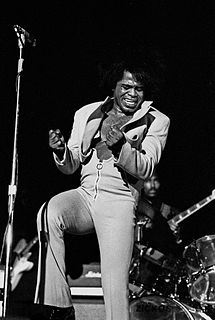
James Joseph Brown was an American singer, dancer, musician, record producer, and bandleader. The central progenitor of funk music and a major figure of 20th century music, he is often referred to by the honorific nicknames "Godfather of Soul", "Mr. Dynamite", and "Soul Brother No. 1". In a career that lasted more than 50 years, he influenced the development of several music genres. Brown was one of the first 10 inductees into the Rock and Roll Hall of Fame at its inaugural induction in New York on January 23, 1986.
Rhythm and blues, frequently abbreviated as R&B or R'n'B, is a genre of popular music that originated in African-American communities in the 1940s. The term was originally used by record companies to describe recordings marketed predominantly to urban African Americans, at a time when "urbane, rocking, jazz based music with a heavy, insistent beat" was becoming more popular. In the commercial rhythm and blues music typical of the 1950s through the 1970s, the bands usually consisted of piano, one or two guitars, bass, drums, one or more saxophones, and sometimes background vocalists. R&B lyrical themes often encapsulate the African-American experience of pain and the quest for freedom and joy, as well as triumphs and failures in terms of relationships, economics, and aspirations.
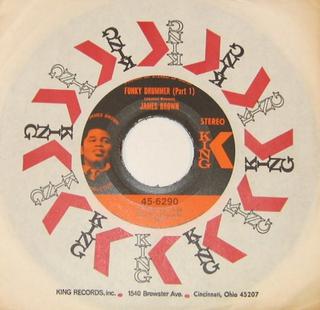
"Funky Drummer" is a single released by James Brown in 1970. Its drum break, improvised by Clyde Stubblefield, is one of the most frequently sampled music recordings.

Clyde Austin Stubblefield was an American drummer best known for his work with James Brown. A self-taught musician, he was influenced by the sound of natural rhythms around him. His drum patterns on Brown's recordings are considered funk standards. He recorded and toured with Brown for six years and settled in Madison, Wisconsin, where he was a staple of the local music scene. Often uncredited, samples of his drum patterns were heavily used in hip hop music. He was the recipient of an honorary doctorate in fine arts.

"I Got You " is a song by American singer James Brown. First recorded for the album Out of Sight and then released in an alternate take as a single in 1965, it was his highest-charting song and is arguably his best-known recording.
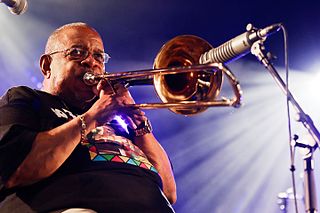
The J.B.'s was the name of James Brown's band from 1970 through the early 1980s. On records the band was sometimes billed under alternate names such as Fred Wesley and the JBs, The James Brown Soul Train, Maceo and the Macks, A.A.B.B., Fred Wesley and the New JBs, The First Family, and The Last Word. In addition to backing Brown, the J.B.'s played behind Bobby Byrd, Lyn Collins, and other singers associated with the James Brown Revue, and performed and recorded as a self-contained group. In 2015, they were nominated for induction into the Rock and Roll Hall of Fame but failed to be inducted and can be considered for Musical Excellence in the future. They have been eligible since 1995.

Sex Machine is a 1970 double album by James Brown. It showcases the playing of the original J.B.'s lineup featuring Bootsy and Catfish Collins, and includes an 11-minute rendition of the album's title song, different from the original recording of the title song which was released as a two-part single in 1970.

"Say It Loud – I'm Black and I'm Proud" is a funk song performed by James Brown, and written with his bandleader Alfred "Pee Wee" Ellis in 1968. It was released as a two-part single which held the number-one spot on the R&B singles chart for six weeks, and peaked at number ten on the Billboard Hot 100. Both parts of the single were later included on James Brown's 1968 album A Soulful Christmas and on his 1969 album sharing the title of the song. The song became an unofficial anthem of the Black Power movement.

"Papa's Got a Brand New Bag" is a song written and recorded by James Brown. Released as a two-part single in 1965, it was Brown's first song to reach the Billboard Hot 100 Top Ten, peaking at number eight, and was a number-one R&B hit, topping the charts for eight weeks. It won Brown his first Grammy Award, for Best Rhythm & Blues Recording.
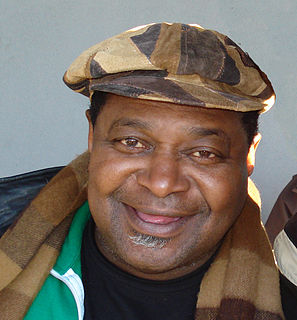
Alfred James Ellis, known as Pee Wee Ellis due to his diminutive stature, was an American saxophonist, composer, and arranger. With a background in jazz, he was a member of James Brown's band in the 1960s, appearing on many of Brown's recordings and co-writing hits like "Cold Sweat" and "Say It Loud – I'm Black and I'm Proud". He also worked with Van Morrison.

John Henry "Jabo" Starks ( ; October 26, 1938 – May 1, 2018) was an American funk and blues drummer best known for playing with James Brown as well as other notable musicians including Bobby Bland and B.B. King. A self-taught musician, he was known for his effective and clean drum patterns. He was one of the originators of funk drumming, and is one of the most sampled drummers.
Jimmy Nolen was an American guitarist, known for his distinctive "chicken scratch" lead guitar playing in James Brown's bands. In its survey of "The 100 Greatest Guitarists of All Time," the English magazine Mojo ranks Nolen number twelve.

"Mother Popcorn " is a song recorded by James Brown and released as a two-part single in 1969. A #1 R&B and #11 Pop hit, it was the highest-charting of a series of recordings inspired by the popular dance the Popcorn which Brown made that year, including "The Popcorn", "Lowdown Popcorn", and "Let a Man Come In and Do the Popcorn".
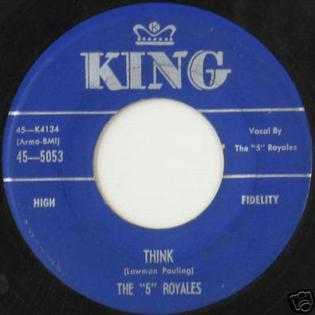
"Think" is a rhythm and blues song written by Lowman Pauling and originally recorded by his group The "5" Royales. Released as a single on King Records in 1957, it was a national hit and reached number nine on the U.S. R&B chart.
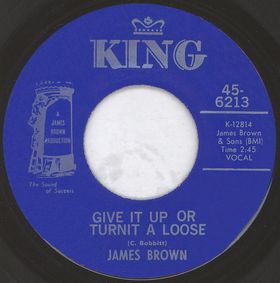
"Give It Up or Turnit a Loose" is a funk song recorded by James Brown. Released as a single in 1969, the song was a #1 R&B hit and also made the top 20 pop singles chart. "Give It Up or Turnit a Loose" appeared as an instrumental on the Ain't It Funky (1970) album, removing Brown's vocals and adding guitar overdubs, while the vocal version was released on It's a New Day – Let a Man Come In (1970).

"I Got the Feelin'" is a funk song by James Brown. Released as a single in 1968, it reached No. 1 on the R&B chart and #6 on the pop chart. It also appeared on a 1968 album of the same name.

"Out of Sight" is a funk song recorded by James Brown in 1964. A twelve-bar blues written by Brown under the pseudonym "Ted Wright", the stuttering, staccato dance rhythms and blasting horn section riffs of its instrumental arrangement were an important evolutionary step in the development of funk music.
Ohio Players is an American funk band, most popular in the 1970s. They are best known for their songs "Fire" and "Love Rollercoaster"; as well as for their erotic album covers that featured nude or nearly nude women. Many of the women were models featured in Playboy.
Say It Live and Loud: Live in Dallas 08.26.68 is a live album by James Brown released in 1998. Taped at Dallas Memorial Auditorium soon after "Say It Loud – I'm Black and I'm Proud" had been released to the airwaves, it includes one of the only live recordings of the song, with the arena crowd shouting the call and response portions. Village Voice critic Robert Christgau deemed it the second best live recording from Brown's "crucial" 1967–71 period, behind 1970's Sex Machine. Following the 50th anniversary of the recording, the entire performance, including never before released live performances of "That's Life" and "The Popcorn", was released on vinyl by Republic Records on October 12, 2018.
References
- ↑ "100 Greatest Funk Songs". Digital Dream Door. August 7, 2008. Archived from the original on September 25, 2010. Retrieved October 7, 2021.
- ↑ Whitburn, Joel (2004). Top R&B/Hip-Hop Singles: 1942–2004. Record Research. p. 84.
- ↑ White, Cliff (1991). "Discography". In Star Time (pp. 54–59) [CD booklet]. New York: PolyGram Records.
- ↑ "GRAMMY Hall of Fame". October 18, 2010.
- ↑ Brown, James, and Bruce Tucker (1986). James Brown: The Godfather of Soul, 173. New York: Thunder's Mouth Press.
- ↑ James Brown's Musicians Reflect On His Legacy. Down Beat. Retrieved February 15, 2007.
- ↑ Smith, R.J. (2012). The One: The Life and Music of James Brown, 173. New York: Gotham Books.
- ↑ Nelson George, The Death of Rhythm & Blues (New York: Pantheon Books, 1988), 101.
- ↑ Rickey Vincent, Funk: The Music, The People, and The Rhythm of The One (New York: St. Martin's Griffin, 1996), 123.
- ↑ Vincent, Funk, 123.
- ↑ Peter Guralnick, Sweet Soul Music: Rhythm and Blues and the Southern Dream of Freedom (New York: HarperCollins, 1986), 242.
- ↑ Fred Wesley Jr., Hit Me, Fred: Recollections of a Sideman (Durham: Duke University Press, 2002), 80.
- ↑ Dave Marsh, The Heart of Rock & Soul : The 1001 Greatest Singles Ever Made (New York: New American Library, 1989), 451.
- ↑ Leeds, Alan, and Harry Weinger (1991). "Star Time: Song by Song". In Star Time (pp. 46–53) [CD booklet]. New York: PolyGram Records.